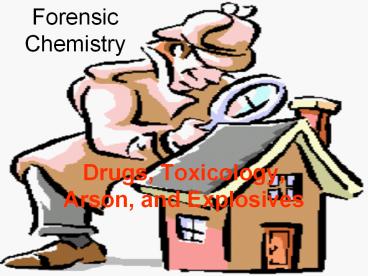Forensic%20Chemistry - PowerPoint PPT Presentation
Title:
Forensic%20Chemistry
Description:
Forensic Chemistry Drugs, Toxicology, Arson, and Explosives What Chemistry Is The study of the composition and transformation of matter Composition what it is ... – PowerPoint PPT presentation
Number of Views:350
Avg rating:3.0/5.0
Title: Forensic%20Chemistry
1
Forensic Chemistry
- Drugs, Toxicology, Arson, and Explosives
2
What Chemistry Is
- The study of the composition and transformation
of matter - Composition what it is made of
- Transformation what happens when it reacts
- Used in fingerprinting, firearms, document
analysis, trace evidence examination, and by
itself
3
Types of Drugs
- Narcotics Relieve pain by depression of the
central nervous system and sleep. - Mostly derived from opium (from poppy plant)
- Morphine (pain killer), codeine (cough
suppressant), heroin (made from morphine),
methadone (synthetic opiate). - Many are addictive
4
(No Transcript)
5
- Depressants Depress central nervous system.
- Alcohol (50 of killers and 40 of victims are
intoxicated), barbiturates (downers),
methaqualone (sedative), tranquilizers (valium),
chloral hydrate (knock-out drops), huffing
substances (glue, toluene, gasoline, etc.) - Stimulants stimulate central nervous system and
provide alertness and decreased appetite. - Amphetamine or methamphetamine, cocaine
6
(No Transcript)
7
- Hallucinogens Mood- and perception-altering
drugs - Peyote, mescaline, psilocybin, lysergic acid
diethylamide (LSD), dimethyltryptamine (DMT),
marijuana and hashish (from hemp plant) - Drug Tests Start with Screening Tests
- Spot tests - place chemical in spot plate and add
chemical. Color change indicates the drug may be
present. - Also use microscopic tests and UV spectroscopy
8
(No Transcript)
9
- Confirmatory Tests
- Infrared Spectrophotometry Substance is
subjected to all wavelengths of IR light, and
will absorb at certain frequencies. Each
substance will absorb differently at each
frequency (based on vibration of its chemical
bonds) IR fingerprint. - Gas Chromatography-Mass Spectrometry (GCMS) GC
separates components of the mixture, and MS
identifies each component (by molar mass)































